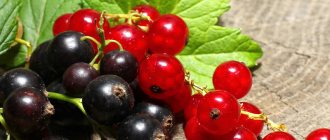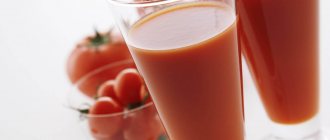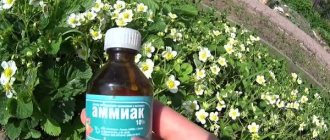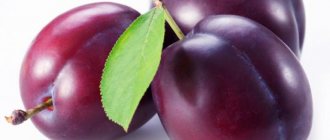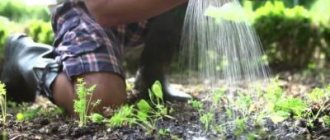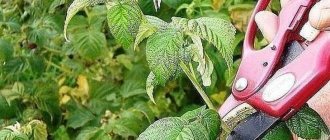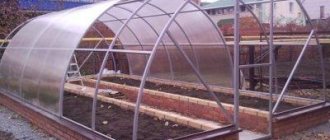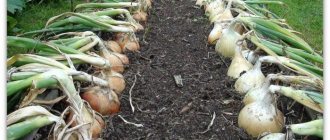With the onset of spring, the awakening of trees and shrubs in the garden begins.
Plants are starting a new season. There are several tricks to help them “wake up” and protect them from parasites and diseases. We will talk about one of these agricultural techniques in this article. Dear readers! For you, we have created communities on social networks in which useful articles and interesting ideas are published several times a day! Subscribe and receive useful content in a convenient format!
Why pour boiling water over currants?
During the winter, insect pests and spores of pathogenic fungi seek shelter. One of the most favorite plants for parasites is currants. On this shrub, bud mite larvae, aphids, and various fungi (most often powdery mildew spores) are waiting for the onset of warm weather.
If you spill boiling water on currants, the egg clutches, larvae and spores will die from the high temperature.
ON A NOTE. Dousing with hot water is essential for plants that are already infected. Mites and aphids reproduce very quickly. If you don’t fight them, they will eat all the greens and you will be left without a berry harvest.
Another reason to process currants with boiling water is as follows. During the summer season, currants have to be treated several times with chemicals to stimulate growth and fruit formation, prevent and protect against pests and diseases.
Even if the permissible concentration of active drugs is observed, a certain amount of toxins will accumulate in the plant over the course of a whole year. Treatment with very hot water allows the plant to release chemical elements.
The third reason to carry out the treatment is hardening off the bushes. Treated currants become more resistant to adverse environmental conditions, pests and diseases.
An alternative to dousing with boiling water
There is a method that some gardeners find more convenient. In this case, the bush is covered with a large plastic bag, and a bucket is placed under it, into which hot water is poured. Hot steam comes from the boiling water, and it envelops all the shoots and branches, remaining there for quite a long time. It is enough for insect pests to leave their shelters. Another alternative method that is economical is the use of a steam generator.
It must be borne in mind that in reality one should not expect a strong effect from such a procedure. It is significantly lower than from the use of fungicidal and insecticidal preparations. However, pouring boiling water over black, yellow and red currant bushes in the spring is an old method of combating fungal diseases and pests, and it is also completely free and simple.
When to pour boiling water over currants in spring?
There is no exact date for the procedure. Every year, based on the weather and the condition of the bushes, summer residents again choose the day to treat currants with boiling water.
The procedure is carried out when the snow has already begun to melt, but the plant has not yet woken up and sap flow has not begun.
IMPORTANT! If the kidneys begin to swell, then it is too late to carry out the procedure!
In cold weather, pouring boiling water over the plant is also not advisable. You need to wait for 5-10 degrees Celsius.
The approximate time frames for Russian regions are as follows:
- Southern and Southwestern regions - the first half of March;
- Central Russia - starting from the second decade of March;
- Moscow and Moscow region - starting from the second decade of March;
- Ural, Siberia, Northwestern Russia - first half of April;
- North - starting from the second ten days of April.
NOTE! This is an approximate time frame for the work. You need to focus on the weather and air temperature. In warm years, start the procedure earlier. If winter is delayed, take your time and wait for warmer weather.
Timing and features of the procedure
For each region, processing time is selected individually; it may be different every year. Currant bushes should be scalded with hot water at the moment when the snow has already begun to melt and sap flow has not yet intensified.
Attention ! The procedure is carried out before the leaves appear, the buds open and the plant begins to bloom.
It is necessary to wait until the air temperature rises to 10°C. After treating the branches with hot water, it will fall directly on the hiding parasites, and they will die. When to pour boiling water over currants in the spring in 2021 by region is indicated in the table.
| Region | date |
| Moscow region | March 7-16 |
| Central regions | March 8-17 |
| Northern regions | April 11-23 |
| Western and Eastern Siberia | April 1-14 |
| Southern regions | March 1-17 |
In the Moscow region, the procedure begins in early spring; in the Urals and Siberia, the dates are shifted to a later time. They mainly focus on the presence of snow and the formation of buds, because the climate tends to change. In addition, treatment with boiling water is also carried out in the fall. In this case, the goal is to disinfect the soil; thanks to the procedure, fungal spores stop reproducing.
In autumn, the currants are scalded before they begin to dry out, and almost all the greenery flies off the bushes. It must be borne in mind that treatment in the fall will not bring any results in the fight against ticks. The fact is that with the onset of winter, the buds are covered with a crust, and insect pests are under reliable protection. Hot water will not penetrate through stiff buds.
Before work, you need to make a clear plan of which bushes will be doused. If there is no clear action plan, then due to the fact that the boiling water cools down, the positive effect will begin to decline. Those currant bushes whose root system is too close to the surface of the earth, it is advisable to additionally protect it with some kind of material. You can take boards, sheets of iron, plywood and others.
How to properly pour boiling water over currants step by step
Step 1. First of all, you need to prepare. You will need a metal watering can or a kettle with a sprinkler and gloves to avoid burning your hands.
Step 2. We first tie the currant bushes so that all the branches are in one pile. This way there is less chance of missing a branch.
Step 3. Cover the roots if they are near the surface.
Step 4. We pick off the unnaturally large buds of the currants. They are called tick-borne because insects hibernate in them.
Step 5. Boil water, pour it into a watering can and let it cool a little. A comfortable temperature is considered to be between 60 and 80 degrees. There is no need to water the plants with boiling water. Let the water cool slightly.
Step 6. Quickly scald the bush with a watering can, trying to get on every branch.
ON A NOTE. Boiling water consumption is 1 bucket for 2-3 bushes, depending on their size.
Alternative Processing Methods
For heat treatment of the bush, in addition to hot water, other means are used. Some gardeners use a blowtorch or gas torch. The bush is treated with fire in March, when pruning is done. The burner is held so that the flame is at a distance of at least 8 cm from the branches. Each branch is processed 2-3 times, moving the burner from tip to base. As a result, a small coating of soot forms on the shoots.
On a note!
Fire is not terrible for the plant. Healthy kidneys are tightly closed with valves. Therefore, high temperature will not harm them. If there are pests or infectious agents inside the loose buds, they die. This treatment is also possible in the fall, when insects are preparing for winter.
Another way to protect shrubs is steam treatment. The jet is directed directly at the branch, keeping the distance between the nozzle and the plant no more than 3-5 cm. If there is no steam generator, you can place a bucket of boiled water under the bush and cover the top of the plant with film. Hot steam destroys kidney mites and fungal spores.
Is it possible to carry out the procedure in summer?
In summer, currant bushes are in the phase of active growth, flowering and fruiting. During this period of time, it is impossible to treat with boiling water, since you are more likely to harm the plant than to destroy the pests.
In the summer, insecticides are used to control pests, as well as folk remedies that rid plants of pests. But they are all diluted in warm water, and not in boiling water.
Treat with boiling water in the fall, before leaf fall. That is, you need to scald the bushes before they go into hibernation. The fact is that during the winter the currants become woody, and the buds become covered with a kind of crust. As a result, pests that hide in the kidneys do not suffer from boiling water.
Pros and cons of processing
Dousing currant bushes with boiling water has many supporters. This method has significant advantages. However, this method is not universal and has its drawbacks.
| pros | Minuses |
|
|
Features of scalding bushes
The procedure must be carried out quickly. Your task is to scald the bush, and not to wash it in boiling water.
The water should not be exactly 100 degrees. Cool it a little. 80 degrees is the optimal temperature for processing. Cooling below 60 degrees is also pointless. Such watering will not give any effect.
Another important detail that many people miss. Often, currants, especially old bushes, have roots close to the surface or even visible above the ground. They must be protected from direct exposure to boiling water. Cover the roots with film, boards or iron to avoid burning them.
ON A NOTE. Do not use plastic utensils. Due to boiling water, it will become deformed, and toxic plastic compounds will get into the water.
How to water the crop
According to experienced gardeners, the best option would be to water currants using the sprinkling method. Using this method, you can easily evenly moisten the soil around the bush and the crop itself. And to perform sprinkling, it is enough to purchase one of the devices you like at any specialized store, which is fixed on the hose and evenly disperses the water.
It is worth noting that some gardeners recommend watering directly from a hose, simply placing it under a bush. In this case, this method of watering is undesirable. The fact is that it is strictly forbidden to moisten the crop with cold water, since there is a high probability of hypothermia of the root system, as a result, the currants will begin to hurt, and in some cases may even die.
It’s also worth noting one important point: when moistening, you need to make sure that the full amount of water flows under the currant bush and does not flow past.
And to make moisturizing more effective, you can resort to one small trick: dig a groove up to 7 cm deep along the perimeter of the currant crown. Then, water is poured evenly into this groove. By the way, this device is good because you can add fertilizers into the groove, and they will definitely get to the currant root system.
In addition, some gardeners resort to various devices in the form of bricks or boards to direct the water to the desired location. But in this case, there is no need to build so-called mini-dams, and the process itself is quite labor-intensive, but is similar in efficiency to a small ditch.
The optimal amount of water for currants
We discussed how to properly water currants above; all that remains is to find out how much water the garden beauty needs for full growth and fruit formation. First of all, let's start with the fact that this culture loves moisture very much. But it does not tolerate stagnant water. For this reason, hydration should be organized thoughtfully and competently.
If you spray water over the surface of the front garden, the result will be intensive growth of weeds, and overwatering the crop will achieve an even more negative result in the form of bush diseases. Therefore, we approach the issue of hydration competently and slowly, namely:
- before watering, it is necessary to thoroughly loosen the soil and at the same time check how deep the soil has dried;
- if the soil is dry by more than 15 cm, then your shrub needs at least 40 liters of warm and settled water;
- if the soil has dried to a depth of 10 cm, no more than 20 liters of water will be required;
- Well, in the case when the soil has dried to 5 cm, watering is postponed.
However, proper hydration is not everything.
It is important to know how to retain moisture at the currant root in the long term. And in this case, mulch will help you
After you have thoroughly moistened the crop, do not be lazy and mulch the currant bush using any of the available means, namely:
- compost;
- peat;
- rotted sawdust;
- or hay.
One of the components described above will definitely be found on your site. Moreover, there will be a lot of benefits from it. Under such a peculiar coat, the soil will remain moist and loose for a long time.
Moreover, with the help of natural means at hand, air circulation will not be disrupted, which is also important for the currant root system
What other pest control methods are there?
The effectiveness of the method can be enhanced. There are several tricks that will help make processing even more effective.
How to use hot water and potassium permanganate solution
Potassium permanganate is an old and proven remedy in the fight against fungi and bacteria. A light pink potassium permanganate solution will kill more pathogens.
Please note that potassium permanganate must be added AFTER the water has boiled.
How to use a steam cleaner
The optimal temperature of steam should be the same as that of water – 60 – 80 degrees. You can even do it a little hotter, but then you will have to spray from a greater distance.
The disadvantage of the method is quite obvious. You need a steam generator and electricity.
Although there is a slightly more difficult method. You will need oilcloth and a bucket of boiling water. We make a cone from oilcloth and close the bush. We put a bucket of boiling water inside the cone and close the entire structure like a tent.
How to make a solution with urea
The best way to increase the effectiveness of boiling water treatment is to add urea and copper sulfate. A bucket needs 0.5 kg of urea and 0.05 kg of copper sulfate.
These drugs will not only harm pests and diseases, but also saturate the plant with nitrogen, which stimulates the formation of green mass and slightly delays the flowering of currants.
ON A NOTE. The urea needs to be stirred well so that there is no sediment or lumps. The water temperature should be a little colder - 60 - 70 degrees.
Required Tools
To spray hot water on currants, you need a regular metal watering can. Polyethylene is not used, since its walls are deformed under the influence of high temperatures. A bucket is also not suitable for this job. The liquid in it cools down very quickly.
Water is poured into a watering can when it boils, and they immediately begin to spray the branches. For effectiveness, a drug is added to the liquid that destroys parasites and infectious agents. Potassium permanganate, copper sulfate, and table salt are suitable for this. High solution temperatures do not reduce the effectiveness of these substances.
Common mistakes
- The most common and serious mistake that gardeners make is treating it with boiling water when the buds have begun to bloom on the plant. Yes, in this case, you will destroy the pests, but you will also harm the plant.
- Treatment with boiling water. The water must cool slightly, otherwise you will injure the currants.
- Treatment with warm, not hot water. Water colder than 60 degrees will not do any good.
- The roots were not covered. The roots are the most important part of the plant and must be protected. Therefore, when processing currants with boiling water, you need to spread an oilcloth under the bushes.
- The plant is exposed to very hot water for too long. The whole procedure should take no more than 5-10 seconds. There is no need to use boiling water longer. That is why, before watering, preparation is carried out, during which the branches are collected in one bunch.
- Not all shoots have been processed. If you haven’t doused some branches, the effectiveness of the procedure is reduced. An untreated shoot becomes a source of infection.
Recommended timing
In early spring, before the snow melts and active growth begins, the shrub is inspected. Currants are one of the first to emerge from hibernation after winter. Therefore, you need to water the bushes with hot water as quickly as possible. To accurately determine the date of treatment, the age and condition of the plant, climatic conditions in the region, and recommendations of the Lunar calendar for performing spring work are taken into account.
Answers to frequently asked questions
Why carry out the procedure?
Watering with boiling water helps fight pests and fungi, improves the plant's immunity, helps it remove toxins and awakens currants from hibernation.
What to add to boiling water to increase the effectiveness of the method?
Dilute urea and copper sulfate (Bordeaux) in hot water. These drugs will increase the percentage of destroyed pests and pathogenic microorganisms, and also saturate the currants with nitrogen.
What temperature should the water be?
Optimal is 80 degrees. There is no need to work with boiling water, and do not forget to cover the roots of the plant.
Do you need to process all the currants?
Practically. Do not scald very young bushes, as well as those where the buds are already swelling.
When else to carry out the procedure?
You can carry out scalding in the fall, after the end of the gardening season, but before the moment when the currants become woody.
What are the alternatives to dousing with boiling water?
One alternative method is steam treatment. You can use a steam generator, or you can hide a currant bush in a tent made of plastic film and put a bucket of boiling water inside.

